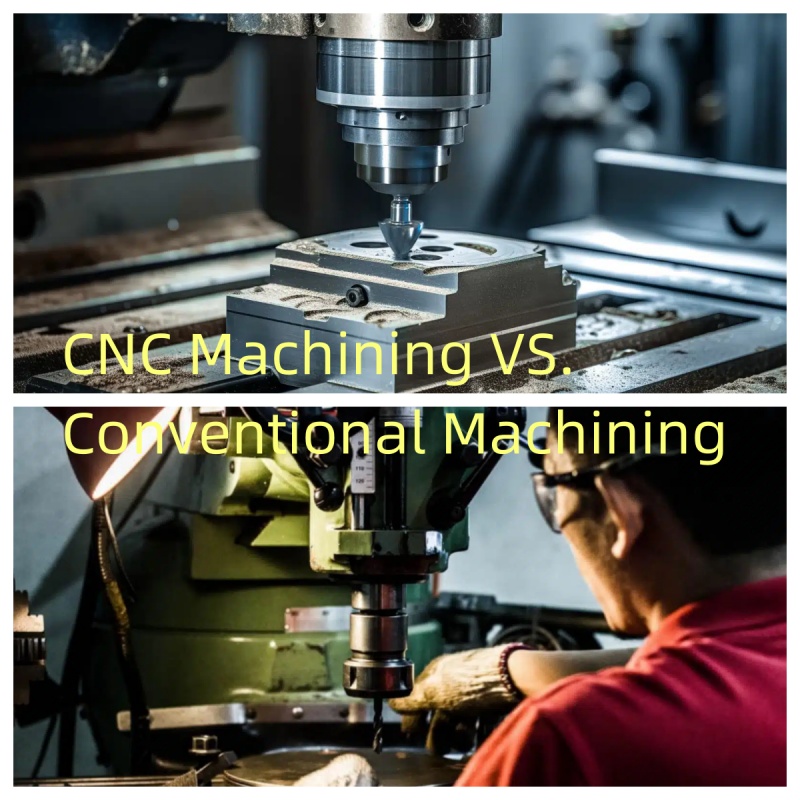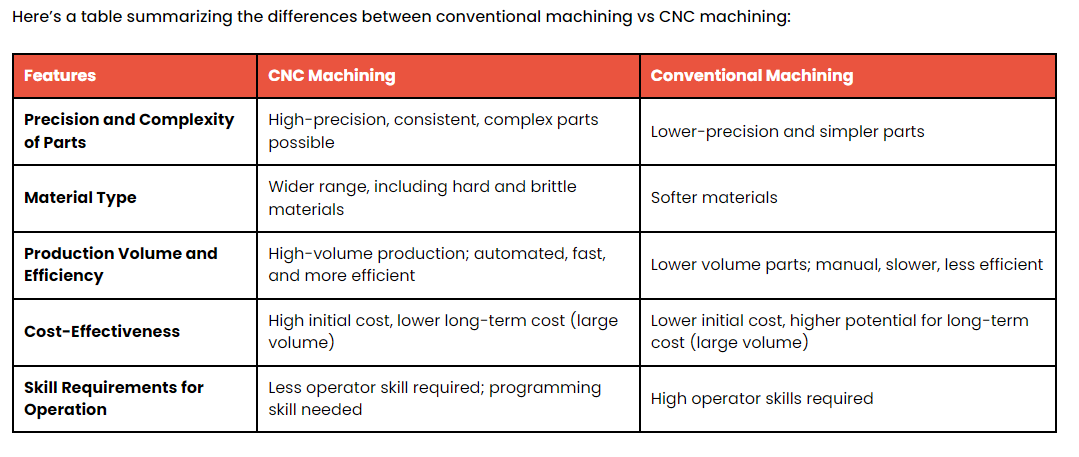CNC Machining vs Conventional Machining: Making the Right Choice

In the manufacturing industry, various methods bring products to life, each suited to different projects. Understanding these techniques is crucial to determining the best fit for your applications. Today, we delve into two transformative machining techniques: CNC machining vs conventional machining. Each method has distinct advantages and drawbacks, influencing modern production.
CNC machining automates processes traditionally done manually, using computerized controls to shape materials with unparalleled precision. Conversely, conventional machining relies on manual guidance from skilled operators.
In this guide, we delve into both CNC and conventional machining, exploring their mechanisms, strengths, and limitations. Our goal is to empower you with the knowledge needed to make informed decisions for your project. But before we delve into their differences, let's understand their basic principles.
What is CNC Machining?CNC (Computer Numerical Control) machining is a subtractive manufacturing process that employs computerized controls and machine tools to shape raw materials into custom-designed parts. It integrates traditional machining with CNC technology, computer-aided design, and auxiliary manufacturing processes.
Designers use Computer-Aided Design (CAD) software to create digital 3D models of desired parts, which are then translated into instructions (G-code) that CNC machines understand. These machines precisely remove material from a workpiece, guided by computer-controlled motors, resulting in high-quality parts with precise dimensions and intricate details.
Advantages of CNC Machining:
Precision and Repeatability: CNC machines replicate CAD drawings with near-perfect accuracy, ensuring precise results consistently.
Ability to Produce Complex Shapes: CNC machines offer high manufacturing complexity capacity, excelling in creating intricate parts.
Reduced Human Error and Enhanced Safety: CNC machines eliminate errors due to fatigue or misreadings, enhancing safety.
Efficient for High-volume Production: CNC machining minimizes manual intervention, ensuring quicker and more consistent production.
Disadvantages of CNC Machining:
Higher Initial Investment: CNC machines require significant upfront investment, making them less suitable for small-scale businesses.
Requirement for Skilled Operators: Operating CNC machines demands technical expertise, adding to operational expenses.
Less Cost-effective for Very Small Batches: CNC machining may not be efficient for small-scale production due to high setup costs.
What is Conventional Machining?Conventional machining involves shaping materials with manual tools and machines like mills, grinders, and lathes. Operators manually control these machines, adjusting cutting parameters based on experience.
Advantages of Conventional Machining:
Lower Initial Investment: Conventional machining tools are less expensive upfront, making them suitable for small workshops and startups.
Flexibility for Small Batch Production: Conventional machining is adaptable for small-scale production and prototyping.
Easier to Change or Adjust: Operators can make immediate adjustments during the machining process.
Suitable for Simple Parts: Conventional machining efficiently produces parts with basic shapes and machining needs.
Disadvantages of Conventional Machining:
Lower Precision and Repeatability: Conventional machining offers less precision and consistency compared to CNC machining.
Higher Potential for Human Error: Manual control introduces the potential for errors, increasing the risk of inconsistencies.
Slower Production Rate and Efficiency: Manual machining methods operate slower than CNC, reducing efficiency.
Differences Between CNC vs Conventional Machining:
Precision and Complexity of Parts: CNC machining offers higher precision and complexity compared to conventional machining.
Material Type: CNC machining offers greater material versatility, handling a wider range of materials.
Production Volume and Efficiency: CNC machines excel in high-volume production, offering automated and efficient processes.
Cost-Effectiveness: While CNC machining has a higher initial cost, it offers long-term cost advantages for large-volume production.
Skill Requirements for Operation: CNC machining requires less operator skill due to computerized control, ensuring consistent quality.
Conclusion:The choice between CNC and conventional machining depends on specific needs and production objectives. While conventional machining may suit unique projects with lower upfront costs, CNC machining is preferred for high-volume production requiring precision and efficiency. Ultimately, understanding the capabilities of each method is essential for making the right choice for your project.
Dongrun Casting have 20000 square meters facility houses and 200 production & test equipment, From quotation and tooling design to casting and finished machining, we can work with you at every stage. We serves wide range of industries-from Fortune 500 corporations to small and midsize OEMs. Our products includes: Automotive&Trucking, Electric Utility & Communications, Metering System, Hydraulic Industry, Medical Devices, Lighting, Fuel and Gas Pressure, Furniture parts.
More Details : www.dongruncasting.com
